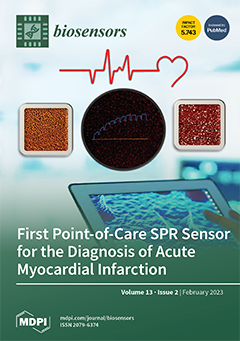Urine analysis is widely used in clinical practice to indicate human heathy status and is important for diagnosing chronic kidney disease (CKD). Ammonium ions (NH
4+), urea, and creatinine metabolites are main clinical indicators in urine analysis of CKD patients. In
[...] Read more.
Urine analysis is widely used in clinical practice to indicate human heathy status and is important for diagnosing chronic kidney disease (CKD). Ammonium ions (NH
4+), urea, and creatinine metabolites are main clinical indicators in urine analysis of CKD patients. In this paper, NH
4+ selective electrodes were prepared using electropolymerized polyaniline-polystyrene sulfonate (PANI: PSS), and urea- and creatinine-sensing electrodes were prepared by modifying urease and creatinine deiminase, respectively. First, PANI: PSS was modified on the surface of an AuNPs-modified screen-printed electrode, as a NH
4+-sensitive film. The experimental results showed that the detection range of the NH
4+ selective electrode was 0.5~40 mM, and the sensitivity reached 192.6 mA M
−1 cm
−2 with good selectivity, consistency, and stability. Based on the NH
4+-sensitive film, urease and creatinine deaminase were modified by enzyme immobilization technology to achieve urea and creatinine detection, respectively. Finally, we further integrated NH
4+, urea, and creatinine electrodes into a paper-based device and tested real human urine samples. In summary, this multi-parameter urine testing device offers the potential for point-of-care testing of urine and benefits the efficient chronic kidney disease management.
Full article






